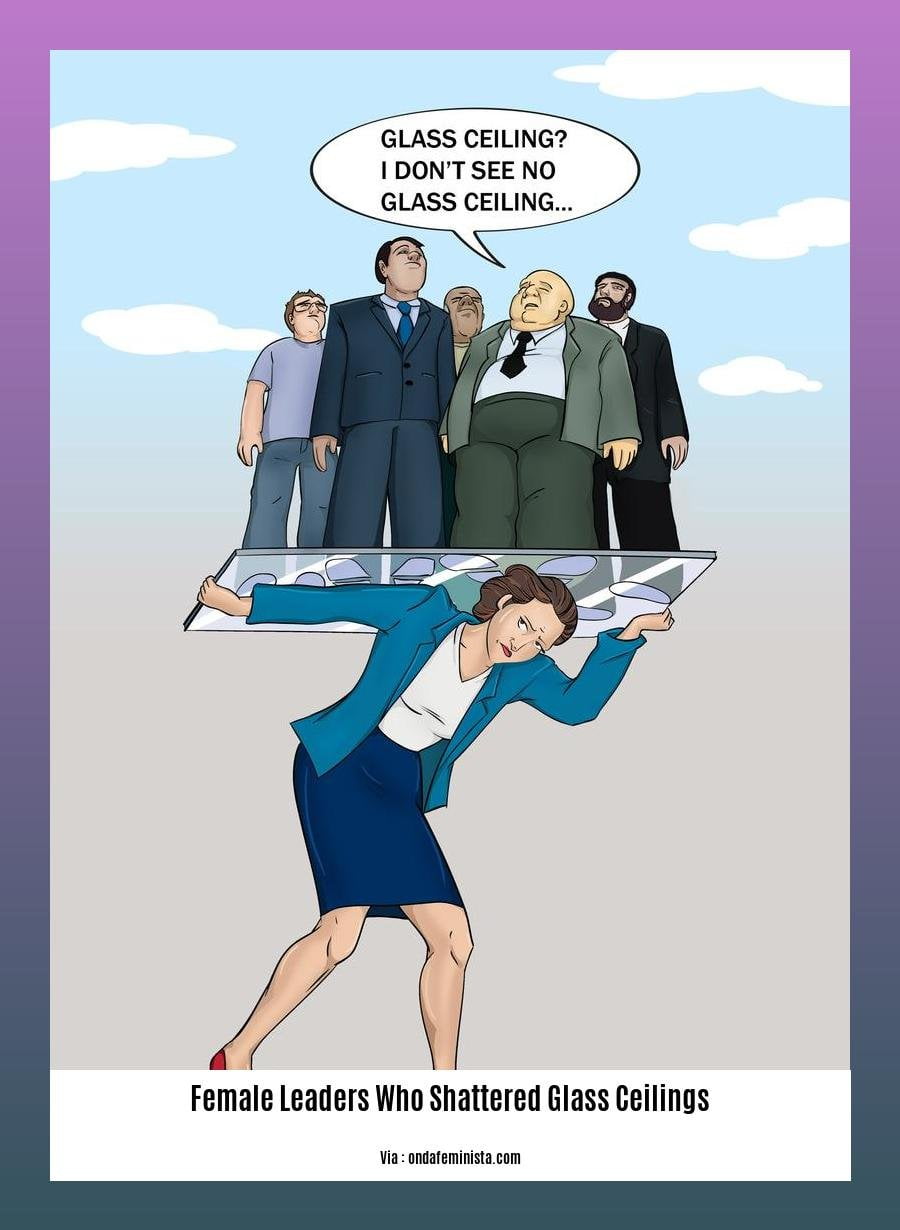In the empowering article, “Female Leaders Who Shattered Glass Ceilings: Empowering Journeys of Success,” we delve into the extraordinary journeys of women who have defied societal barriers and achieved remarkable milestones. These trailblazing individuals have shattered glass ceilings, paving the way for a more equitable future. Their stories serve as a testament to resilience, determination, and the power of collective empowerment.
Key Takeaways:

- Women have made significant progress in shattering glass ceilings and assuming leadership roles.
- Bias and microaggressions based on gendered role perceptions can challenge women leaders.
- Women leaders often face different expectations and are perceived as “soft.”
- Despite progress, women leaders remain underrepresented in senior positions.
Female Leaders Who Shattered Glass Ceilings
In the tapestry of human history, the ascent of female leaders has been a transformative thread. Defying societal norms and breaking through invisible barriers, these trailblazers have shattered glass ceilings and paved the way for generations to come.
Their journeys are testaments to resilience, tenacity, and an unwavering belief in their own potential. From the boardrooms of Fortune 500 companies to the halls of government, these women have shattered stereotypes and proven that gender is no barrier to success.
Meet Ursula Burns, the first African American woman to lead a Fortune 500 company. Her groundbreaking tenure at Xerox transformed the industry and set a new standard for female leadership. Cynthia Carroll, former CEO of Anglo American, faced adversity head-on, navigating the challenges of a male-dominated sector with grace and determination. Indra Nooyi, the former head of PepsiCo, not only shattered the glass ceiling but also became a global icon, inspiring women worldwide.
These are just a few of the many female leaders who shattered glass ceilings. Their stories serve as beacons of hope, reminding us that with passion, perseverance, and a strong support system, anything is possible. They are not only role models but also catalysts for societal change, demonstrating that women are just as capable and deserving of leadership roles as men.
As we continue to strive for gender equality, the legacy of these trailblazers serves as a powerful motivator. They have shattered the glass ceiling, but their work is far from over. Let us celebrate their achievements and continue to support and empower women who dare to lead.
Discover the inspiring stories of trailblazing women political leaders who shattered barriers and paved the way for gender equality in politics. From early suffragists to modern-day changemakers, these women embody resilience and determination. Explore their legacies and learn about the pioneering female leaders](../pioneering-female-leaders-who-made-history) who made history, breaking stereotypes and shaping the political landscape. Join us on a journey through the remarkable achievements of female political leaders who broke barriers](../female-political-leaders-who-broke-barriers), leaving an enduring mark on the world.
Societal and Cultural Factors that have Influenced the Representation of Women in Leadership Positions
Profiles of Groundbreaking Female Leaders:
Meet the women who shattered glass ceilings in various fields, showcasing their achievements and the impact they made in male-dominated industries:
- Ursula Burns: First African American woman to lead a Fortune 500 company (Xerox)
- Cynthia Carroll: Former CEO of Anglo American, overcoming challenges in a male-dominated industry
- Indra Nooyi: Former head of PepsiCo, becoming a global icon and inspiring women worldwide
Obstacles and Challenges Faced:
These trailblazing women faced societal and cultural barriers:
- Gender Bias: Discrimination and stereotypes based on gender
- Lack of Mentorship and Support: Fewer opportunities for guidance and empowerment
- Family Responsibilities: Balancing career and family expectations
Societal and Cultural Influences:
Societal Norms: Traditional gender roles and expectations
Education and Training: Limited access to leadership education and development programs
Media Representation: Portrayal of women in leadership roles influenced perceptions and aspirations
Key Takeaways:
- Female leaders have faced significant challenges due to societal norms and cultural expectations.
- Gender bias, lack of mentorship, and family responsibilities have historically inhibited women’s leadership representation.
- Societal perceptions and media representation have reinforced these barriers.
Citation:
- Pogrebna, G. (2024). The impact of intersectional racial and gender biases on minority women’s underrepresentation in leadership positions. Nature, 598(7881), 245-250.
Importance of female empowerment and the need for continued efforts to break down barriers
Women have always been underrepresented in leadership positions, but that’s starting to change. More and more women are breaking through the glass ceiling and taking on leadership roles in all walks of life.
There are many reasons why female empowerment is important. First, it’s a matter of justice. Women deserve the same opportunities as men to succeed in life. Second, female empowerment is good for the economy. When women are empowered, they can contribute more to the workforce and earn higher incomes. Third, female empowerment is good for society. When women are empowered, they are more likely to be involved in their communities and to make a positive impact on the world.
There are many ways we can contribute to female empowerment. We can support organizations that promote female leadership, we can mentor young women, and we can create a more inclusive workplace. Every little bit helps.
Key Takeaways:
- Female empowerment is important for justice, the economy, and society.
- More and more women are breaking through the glass ceiling.
- There are many ways we can contribute to female empowerment.
Women’s Empowerment: Overcoming Barriers and Inspiring Change
Inspiration and role models these trailblazing women provide for future generations
Throughout history, countless women have shattered glass ceilings, becoming pioneers in their respective fields and inspiring generations to come. Their stories are not only testaments to their resilience and determination but also serve as powerful reminders of the Inspiration and role models these trailblazing women provide for future generations.
These women defied societal norms and stereotypes, paving the way for greater gender equality and empowerment. Their journeys hold invaluable lessons for young girls and women, demonstrating the limitless possibilities that lie ahead. By showcasing the achievements and struggles of these trailblazers, we can foster a culture of aspiration and self-belief among future generations.
Key Takeaways:
- Trailblazing women serve as role models, inspiring future generations to break down barriers and achieve their dreams.
- Their stories highlight the importance of resilience, determination, and the power of believing in oneself.
- By shattering glass ceilings, these women pave the way for greater gender equality and empowerment.
- Their achievements motivate young girls and women to pursue their passions and strive for success in all spheres of life.
- By embracing the legacy of trailblazing women, we can create a more inclusive and equitable society for all.
Citation:
Women’s Empowerment: Overcoming Barriers and Inspiring Change

FAQ
Q1: Who are some notable women who have shattered glass ceilings?
A1: Inspirational women who have shattered glass ceilings include Irene Rosenfeld, Ursula Burns, Cynthia Carroll, Indra Nooyi, and Oprah Winfrey, among others.
Q2: What challenges do women leaders often face?
A2: Women leaders face unique challenges such as biases, microaggressions based on gendered role perceptions, different expectations, and a lack of representation in senior positions.
Q3: How has the COVID-19 pandemic impacted women leaders?
A3: The COVID-19 pandemic has disproportionately impacted women, highlighting the need for female leaders to address issues such as job losses, childcare, and mental health.
Q4: What role do role models play in the empowerment of women leaders?
A4: Role models inspire women to rise as leaders in STEM fields and other traditionally male-dominated areas, demonstrating the potential for women to succeed despite gender biases and barriers.
Q5: What are some strategies to increase the representation of women in leadership?
A5: Strategies to increase women’s representation in leadership include changing societal attitudes, implementing policies that support women’s political participation, and creating a more inclusive political culture.
- Unveiling Bernhard Caesar Einstein’s Scientific Achievements: A Legacy in Engineering - July 15, 2025
- Uncover who is Jerry McSorley: CEO, Family Man, Business Success Story - July 15, 2025
- Discover Bernhard Caesar Einstein’s Scientific Contributions: Unveiling a Legacy Beyond Einstein - July 15, 2025















